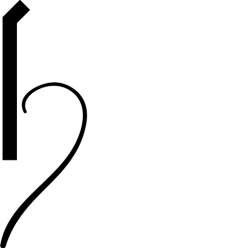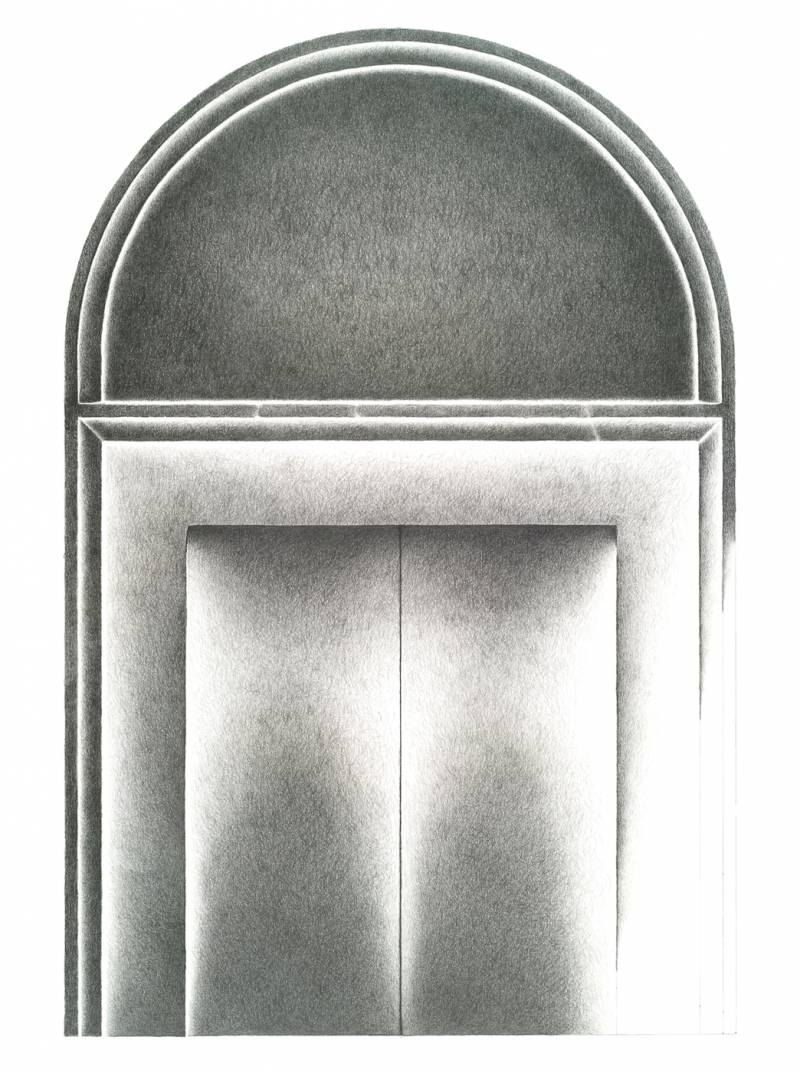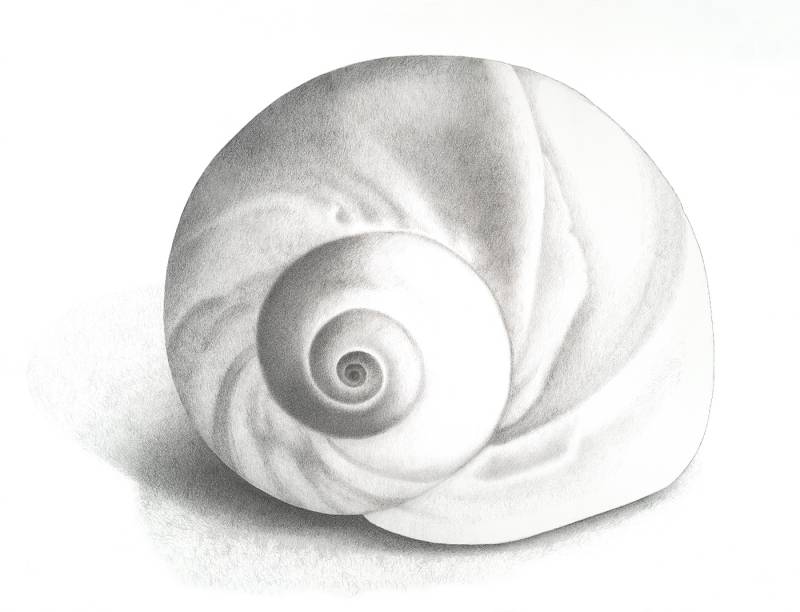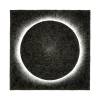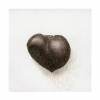Lisa Hoag
G2 Progress Report
Fall 2022
Presentation of Work
“My Practice is a Basket for transformation, enacted through spirit, heart, intuition, body-mind discernment, and clear thought.”
• My Core Mission as an Artist
My mission as an artist is empowerment: to express the quiet conscious power within the subjects of my work—and to support people in accessing their own place of power. My creative process is a journey, a shared relationship of mutual imprinting between myself and my subjects. In the immersive non-verbal space, I experience timeless time. Some larger dimension—a presence that is more than me—passes through my heart to my hand to the canvas. My subject speaks through me. I’m not in charge, I’m a partner. I act as ambassador, listening for the voice that wants to emerge.
This journey becomes embedded in the medium through the marks I make (the attitude with which I approach my work matters). The work accumulates weight, gravity, presence, a resonant frequency that shines back to the viewers. Each person will have their own unique experience with the work. I believe all these experiences become embedded in the work through quantum entanglement.
Native Elders in our Sunray Peacekeeper Teachings speak of the unique song that each person possesses—a song we each sing into manifestation. Creating a work of art is like that—singing a new song into existence; being faithful to the way the song wants to sing itself. Listening deeply manifests the future in the present.
• My Practice is a Basket Embracing Content
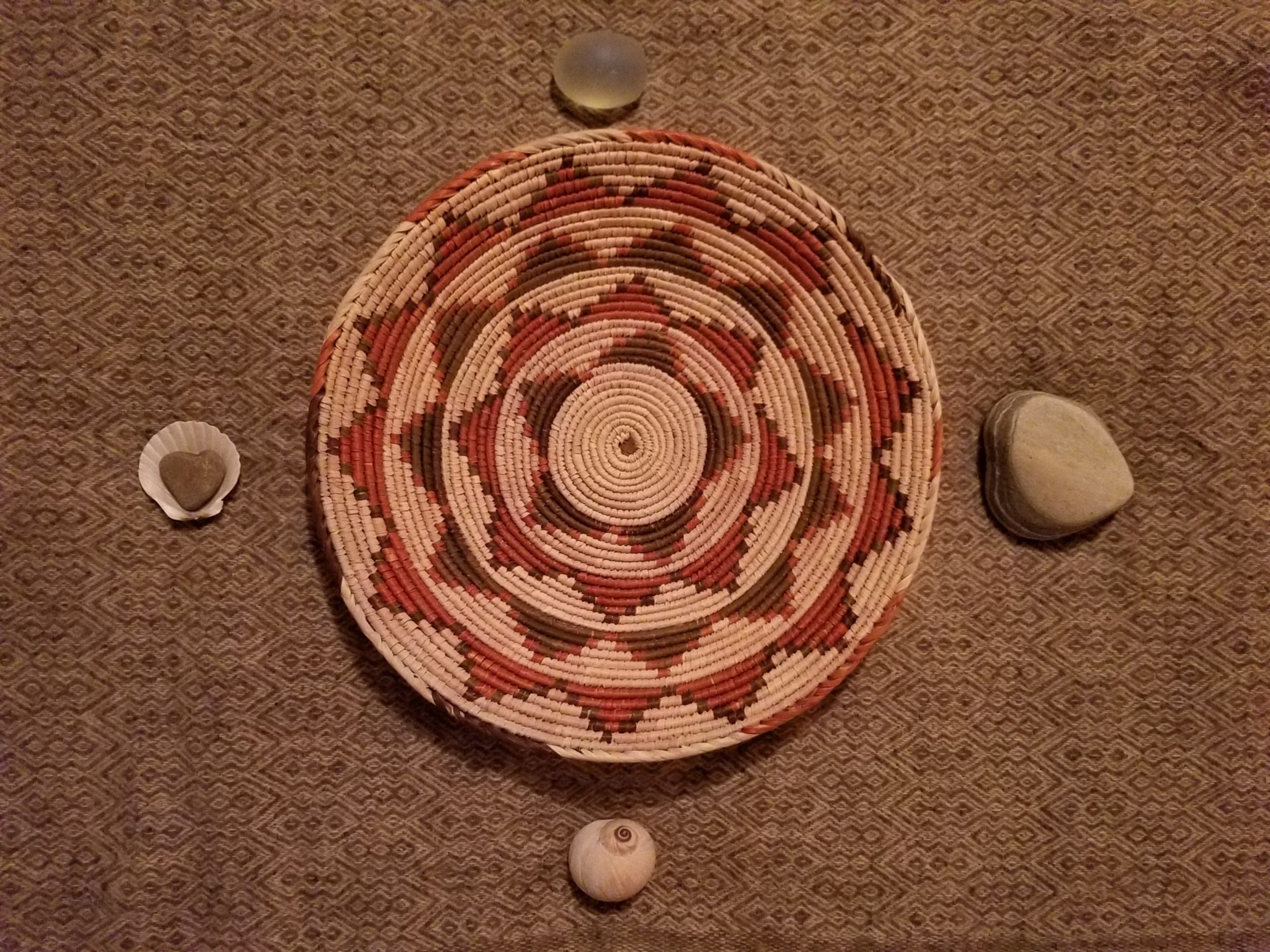
This basket is supported by my guiding stars: points of reference; core concepts which are also my tools.
I speak of these concept clusters below as guiding stars, because I use them as points of reference—not rules. They help me navigate, and correct course when needed. Together, they are a constellation—interconnected. Each focal cluster contains elements of the others, yet each has its own focus. My guiding stars support the basket of my practice, while allowing breathing space for my intuition as I work. These values help me remain fluidly in integrity.
- Dialogue-based Communication, Replacing Dominion Over practices with Mutual Empowerment practices, Replacing Shame-Based Systems with Affirmation-Based Systems, Practicing Discernment rather than Judging.
- Timefulness, Slowing Time, Timeless Time Signatures, Stillness
- Mutual Imprint; Quantum-Entangled Mutual Imprinting
- Spaceful Listening
- Connectedness. Interbeing.
• My Studio Art Practice
1. “Presence Series”: Oak Leaf
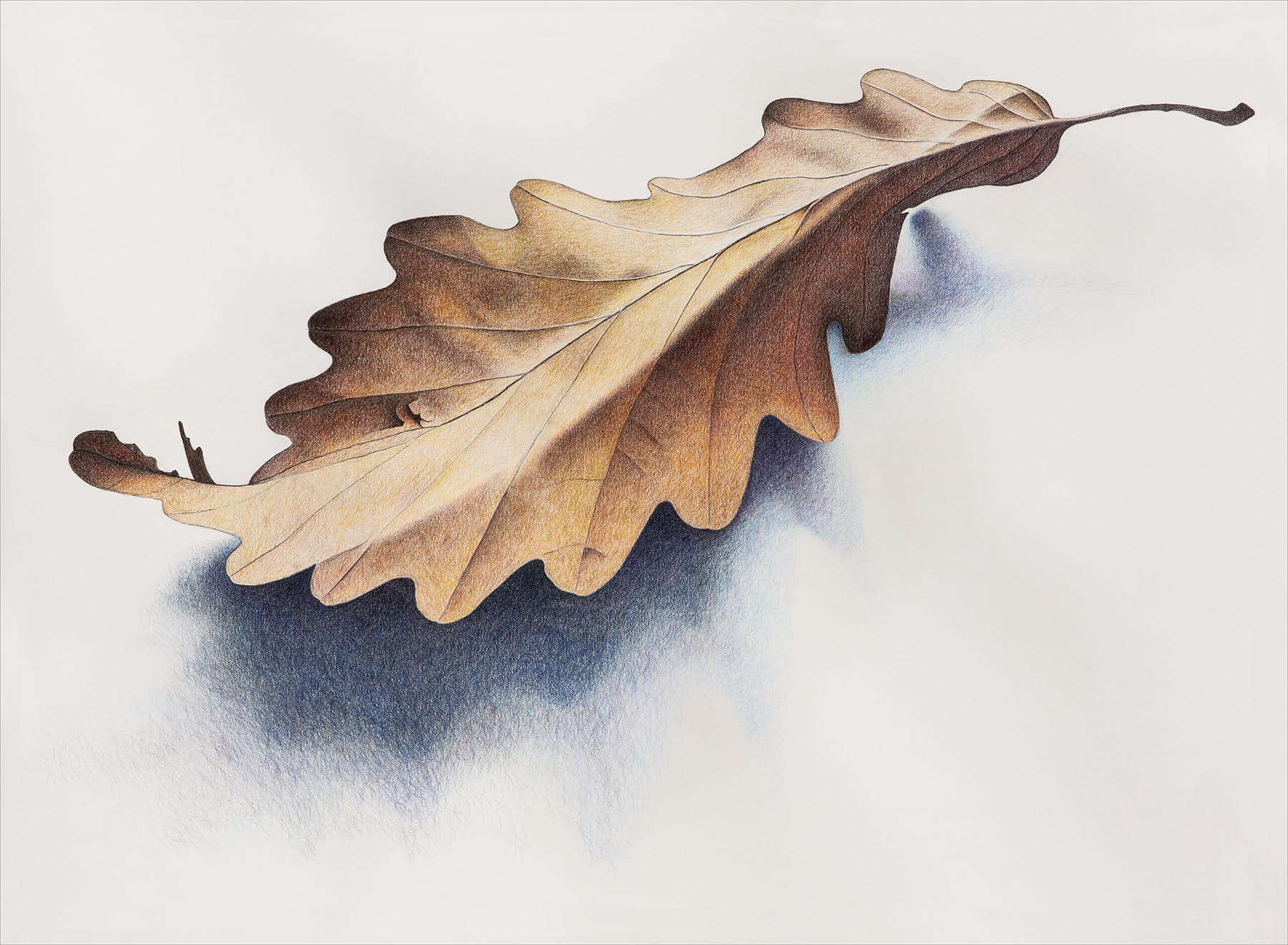
In fall 2021, I completed a large colored pencil drawing, “Oak Leaf.” It is the latest of a series of larger works called “Presence: Witnessing the Voice of Nature,” which I began in 2012.
Some features of this drawing and the Presence Series include:
• Slowed time signature: I take a timeful approach to drawing these works. Drawing is a meditation in which I experience timeless time. As my mark-making accumulates over time, the evolution of my understanding imprints the drawing, soaks into the paper, holds a frequency. Drawing timefully is my commitment to my subject, and my viewers, “You matter. You are worth taking time with—all the time that is needed.”
• Large Scale: These works are “human-size” or slightly larger. This creates a body relationship with the object, not just “eyes and image.” At human scale, these organic objects become our equal, ask to be respected as equals.
• My subjects have a voice of their own. I allow them to speak through my hands. These works sometimes seem like portraits to me.
Sacred Geometry Series:
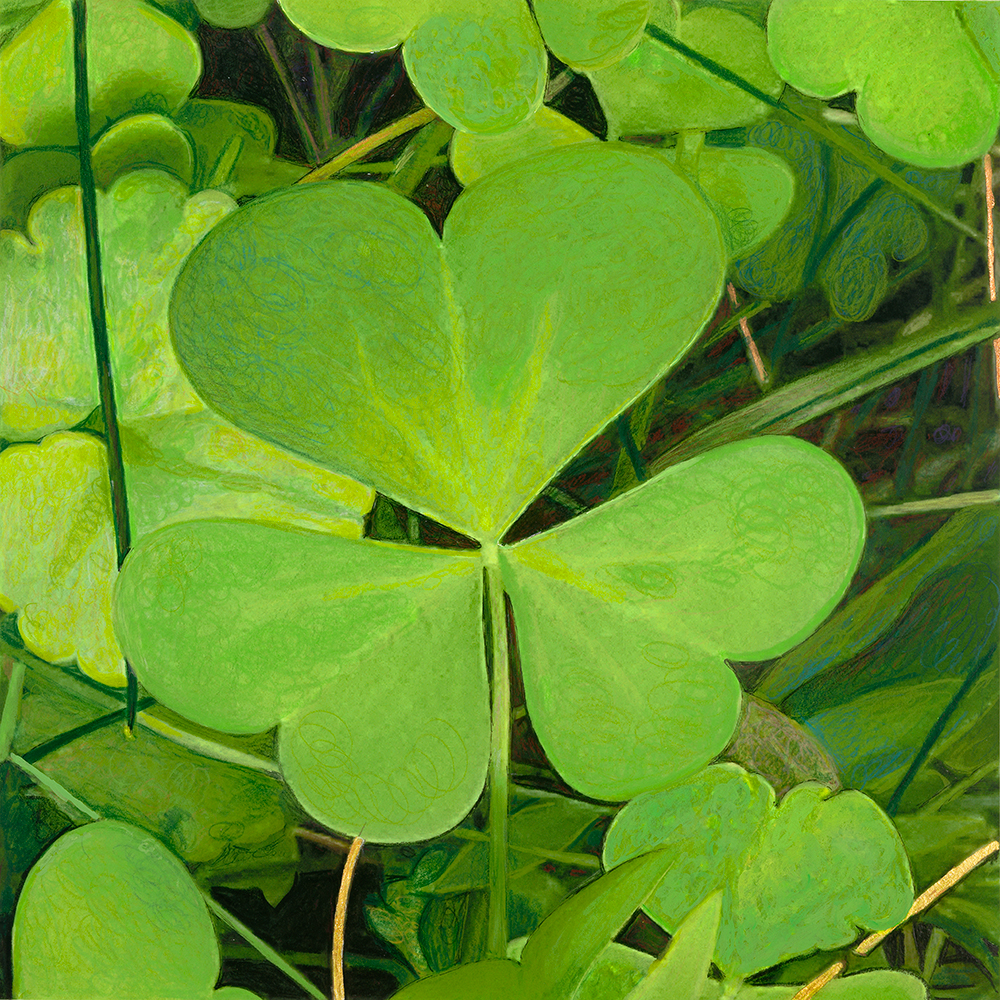
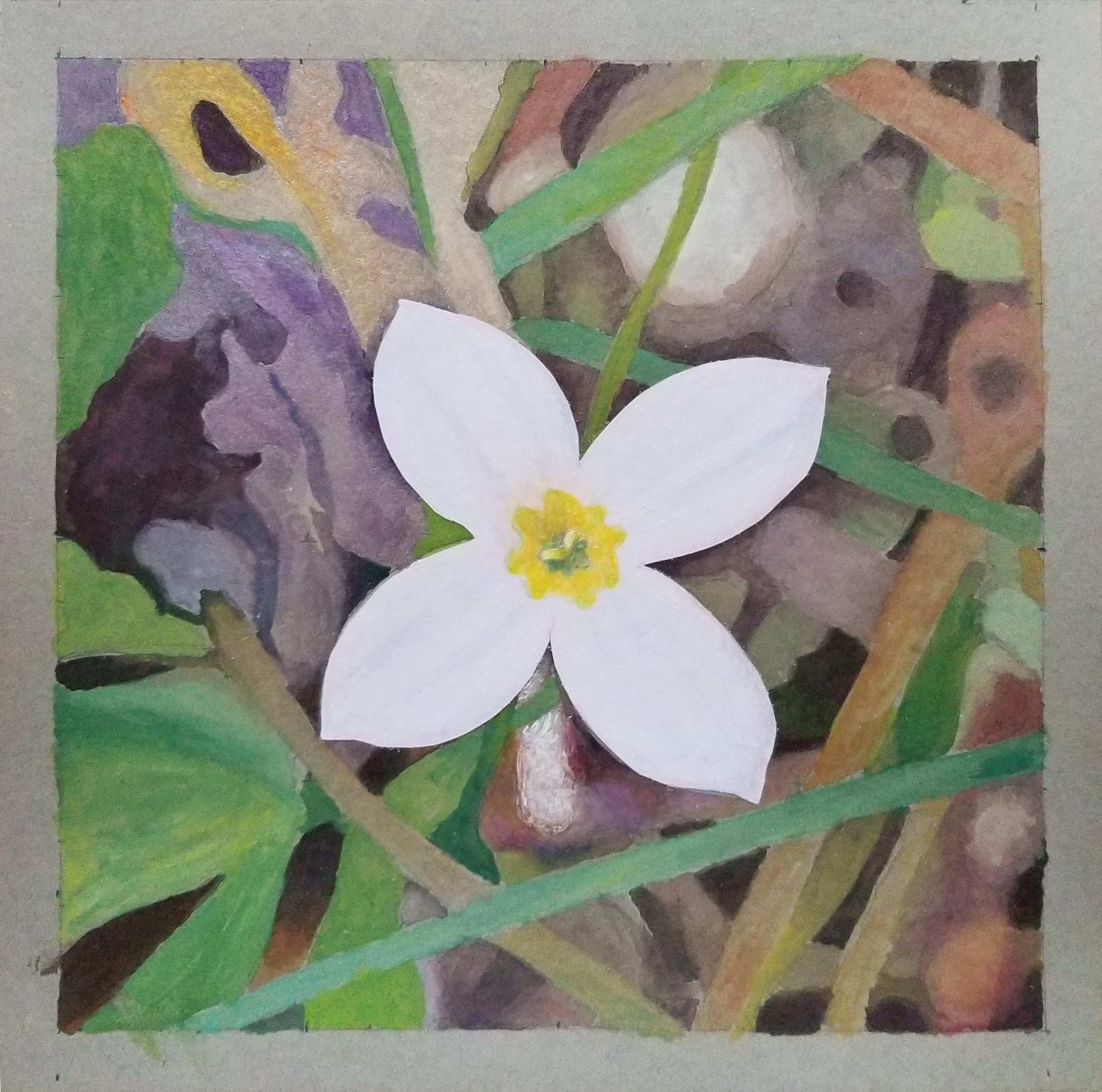
In our Spring 2018 Sunray Peacekeeper Trainings, we were introduced to sacred geometry of the numbers one through ten by our teacher, Venerable Dhyani Ywahoo. This sacred geometry is part of the Tsalagi Basic Elo (Tsalagi basic philosophical teachings; Ywahoo 1987:6). It is called “The Family of Life.” She shared a book, “A Beginner’s Guide to Constructing the Universe: Mathematical Archetypes of Nature, Art, and Science,” by Michael S. Schneider. He considers the numbers one through ten in terms of the harmonious forms they make in nature, art, and mathematics; their cultural symbolism though history; and their sacred archetypal qualities.
I began this Sacred Geometry series in 2018. I wanted to explore these teachings by making a series of drawings and paintings about the numbers one through ten. My Presence Series are large works. For this series, I wanted to try smaller more intimate drawings, trying out a different way for the pieces feel accessible. I completed Three – Wood Sorrel, in Fall 2021, and Four – Bluet, in Fall 2022. I’ve used subjects found in my immediate environment for this series. I believe working with this geometry is about learning in an additive way about how we are interwoven with everything around us. “One,” 2018 is a drawing of the 2017 Eclipse; “Mysterious Seed—Two” is a drawing of a tiny heart-shaped dark brown seed that I found on my front step. I chose Wood Sorrel as my number three image. It has three heart-shaped bright green leaves. I liked carrying through the heart-shaped theme from my heart-shaped seed. I also wanted a chance to work with vibrant “summer” color, since my recent works have all been in very restrained fall/winter tones. For “Wood Sorrel,” and “Bluet,” I included the surrounding environment of plants and grasses. Three is a symbol for “family” in many cultures. The numbers from three and beyond symbolize growing networks of relationships: family, clan, village, nation…. My first two pieces have a white or uniform background. I am struck by the pattern of how many cultures honor the growing sequence of numbers as weaving a gathering web of relationships. In future I may explore a variety of approaches for each of the numbers.
Lastly, my painting style for the last few years has been fairly deliberate. In my earlier years, I often worked much more fluidly. With the Bluet background, I decided to paint quickly and loosely. I didn’t try to define what the shapes were, just be true to their purely abstract form and color. I’m pleased with the result, and the way the colors dance together, though I may rework the bluet flower.
Sacred Geometry Slideshow:
3. “Water Literacy: Trees Make Rain” Project:
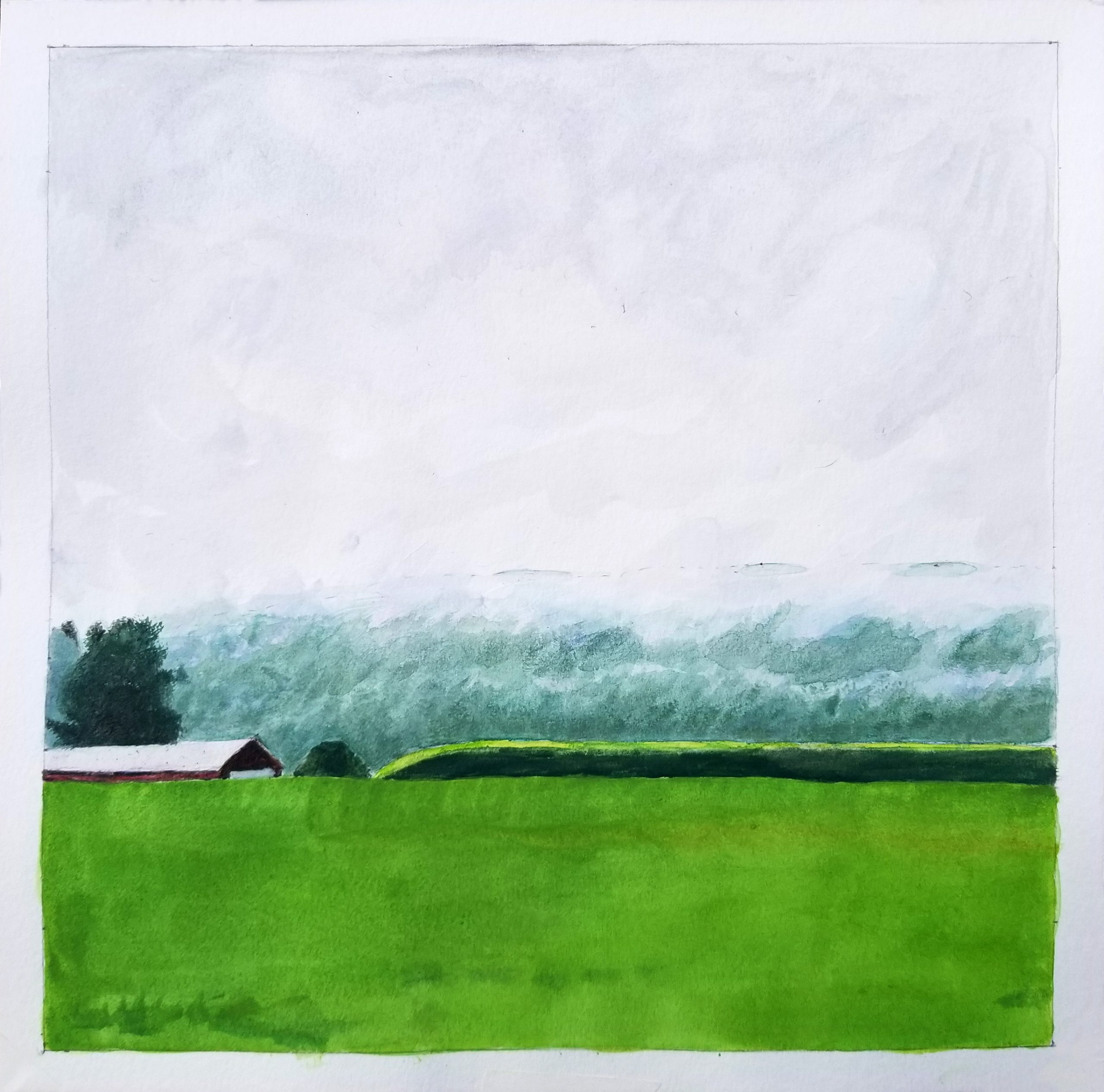
I began this project, “Water Literacy: Trees Make Rain” (working title) this fall. We again experienced a severe drought this summer, in Western Massachusetts. My well was dry for 6 weeks, from late August to mid-October October. These droughts started in 2016, when there was an all-time high deforestation rate in the US (Primary Forest Loss in the US, Global Forest Watch). From 2012 to 2016 the entire Southeastern US was deforested. 2016 was the all time high year for US deforestation. In 2017, the timber industry started heavily logging New England. We’ve rarely had droughts here in the 30 years I’ve lived here, until 2016 when this accelerated deforestation began. I became very involved in forest protection locally from 2016, during our first severe 7-month drought, until 2018, when a group of us tried to stop an industrial scale logging project in Wendell State Forest, in my town. Over a thousand people protested. The forest belongs to the people of the Commonwealth. DCR logged in defiance of the peoples clearly stated guidance.
“Trees Make Rain” is a project I will weave over time. I wish to employ the ability art has to inspire new pathways of awareness in our culture. I am still considering what methods I’ll use, but the general idea is to reweave human communities together along an atmospheric river, and weave in awareness of the vital connection between trees and rain. Trees seed 2/3 of the rain on the planet. Just as trees act as a community, feeding each other their sugars, and transmitting information through the micorrhizal fungi network, human communities could learn to be more like the trees, sharing their sugars with each other. Part of my idea is to heal an atmospheric river—the one that brings rain to my front door, by raising awareness about trees and rain.
I created the water color above as an “introduction” between me, and the rain and trees. When I paint or draw—the simplest of means—I feel my subject becomes aware of me, and sends me more opportunities to learn. I was wondering how mist joins the clouds. One morning, just a week after doing this painting, an instinct called me to go out for breakfast. As I drove down itnot the valley, I saw mist rising from the river. I ended up doing a photoshoot of 75 images (winnowed down to 35) of how mist from the river trees rose up to join the clouds above. I curated this as a photojournal in Google Photos. This allowed me to weave the journal writing in amongst the photo sequence, and experiment with sequencing, until it felt right.
October 16th Photo Journal – River Mist Becoming Clouds
Photojournal: https://photos.app.goo.gl/FJTJ9FXzwXkgJrek8
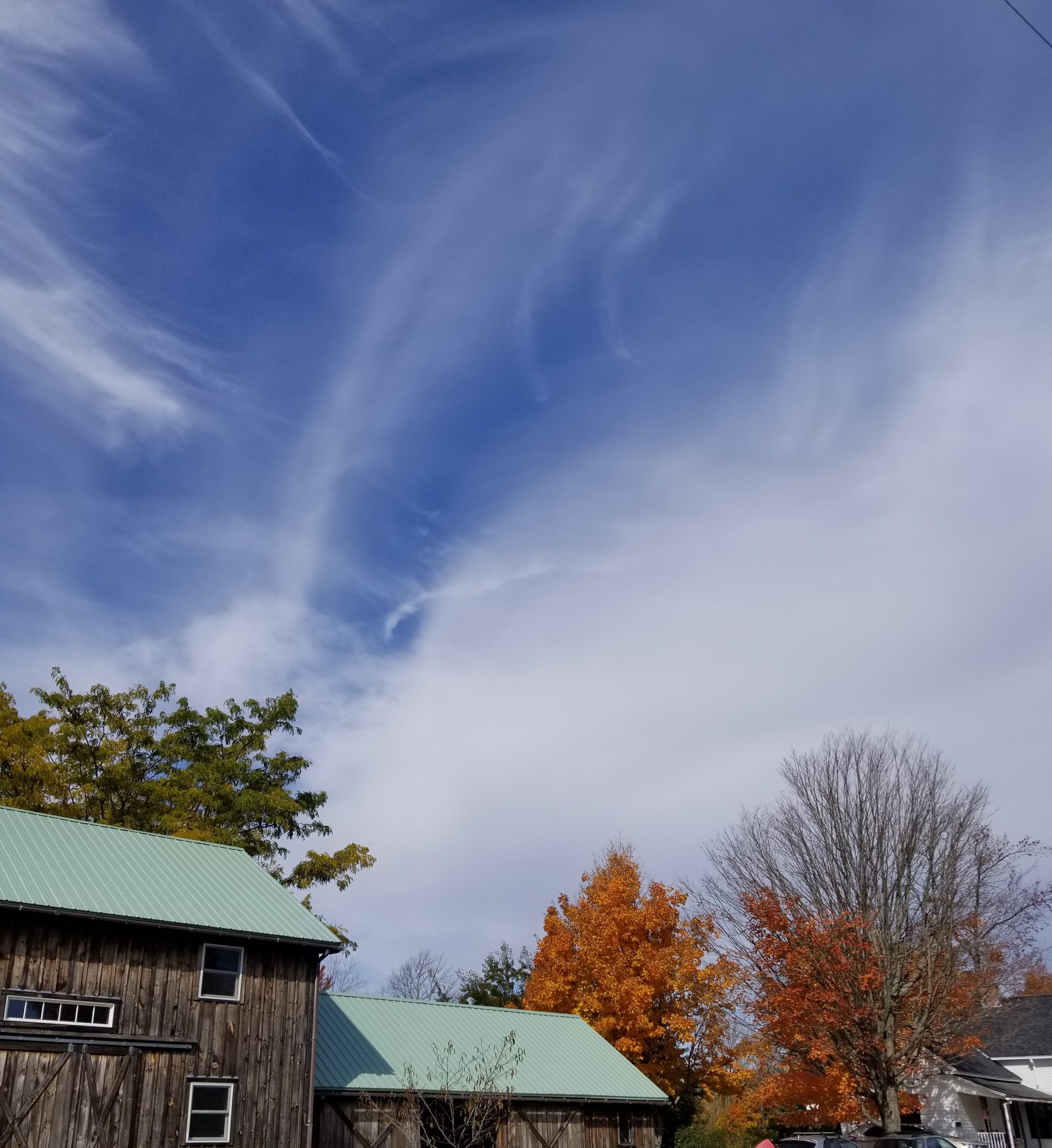
This semester I’ve also written extensively about all the important forest science I learned connecting trees and rain, during my time working on forest protection. I’ve written about deforestation and desertification throughout history, going back to when the Romans created the Sahara; deforestation now. I’ve also written about my artistic lineage with trees (my BFA senior thesis project was about trees), and my personal connections to this work through my family (my grandfather had a lumber company, and my great-great uncle founded a paper company that was the first one to switch to using trees instead of rags for paper). This project is my way of “making right” the harm that my ancestors caused through a lack of awareness. This is a big project, and will likely take longer than my time at Goddard to complete. As with all my work, I plan to take a timeful approach; collaborate with my subject; listen deeply; and take time to discern what feels right to do.
Writings on Trees and Rain:
- Trees and Water and the 2016 Drought.
- Trees are the Life Support System of the Planet.
- Deforestation, Trees, Rain, Desertification in Ancient History.
- My Artistic Lineage and Trees
- My Heritage Lineage with Trees
4. My Art Photography Practice:
Beauty is nourishment. Sometimes I just need to go dance in the world with my camera, and immerse myself in light, line, rhythm, color and composition: a language beyond words. There is nothing more to say except that it feeds my soul, and keeps me whole. Photography is a meditative immersion into pure visual mind, the non-verbal language of visible form. It can also be a way to create experimental working drawings on something multidimensional and too big to draw (like how mist becomes clouds). In my first two semesters I have probably taken close to 700 photographs. These below, are a selection of my favorites.
Photoshoot in Madison, CT
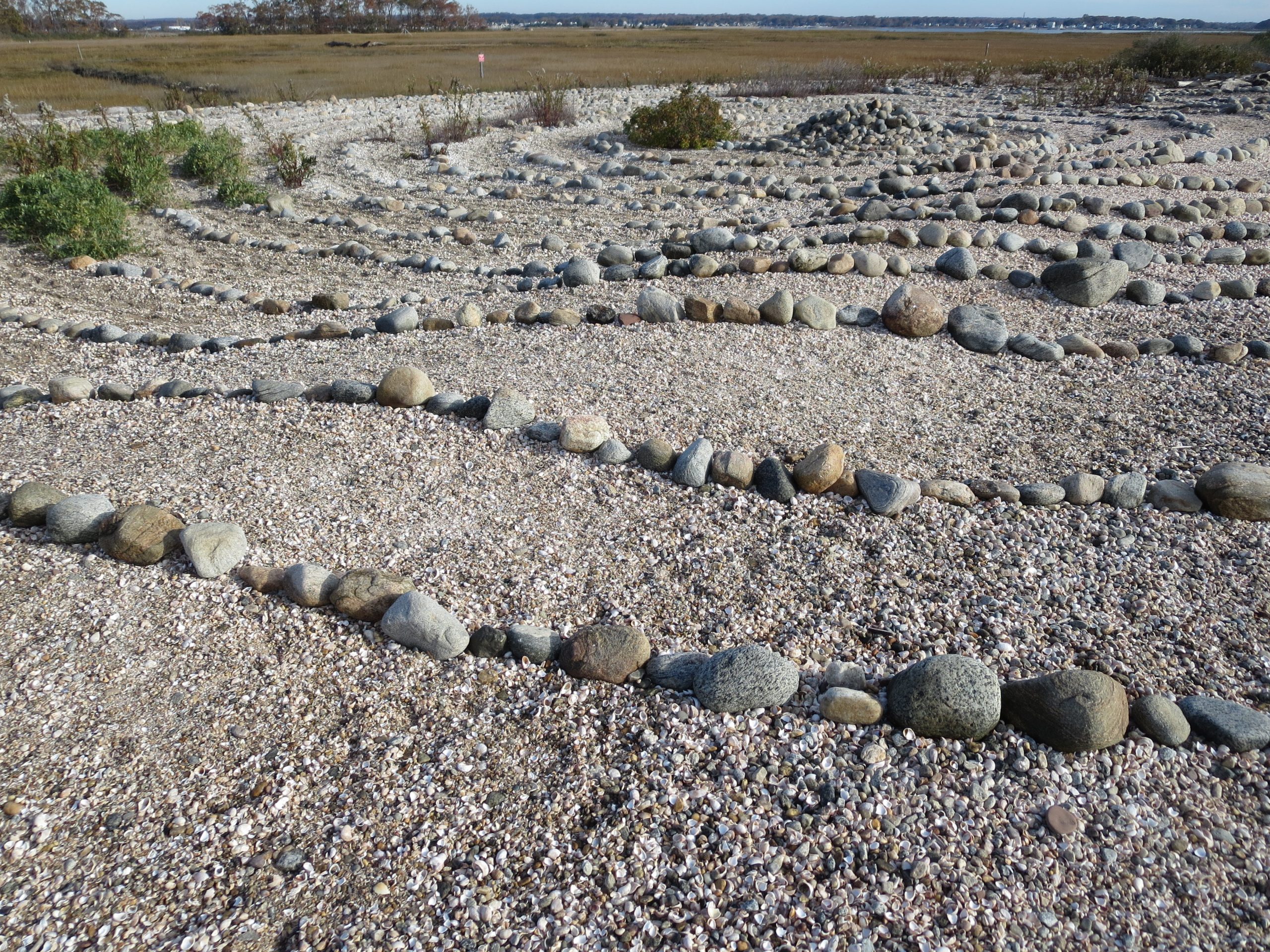
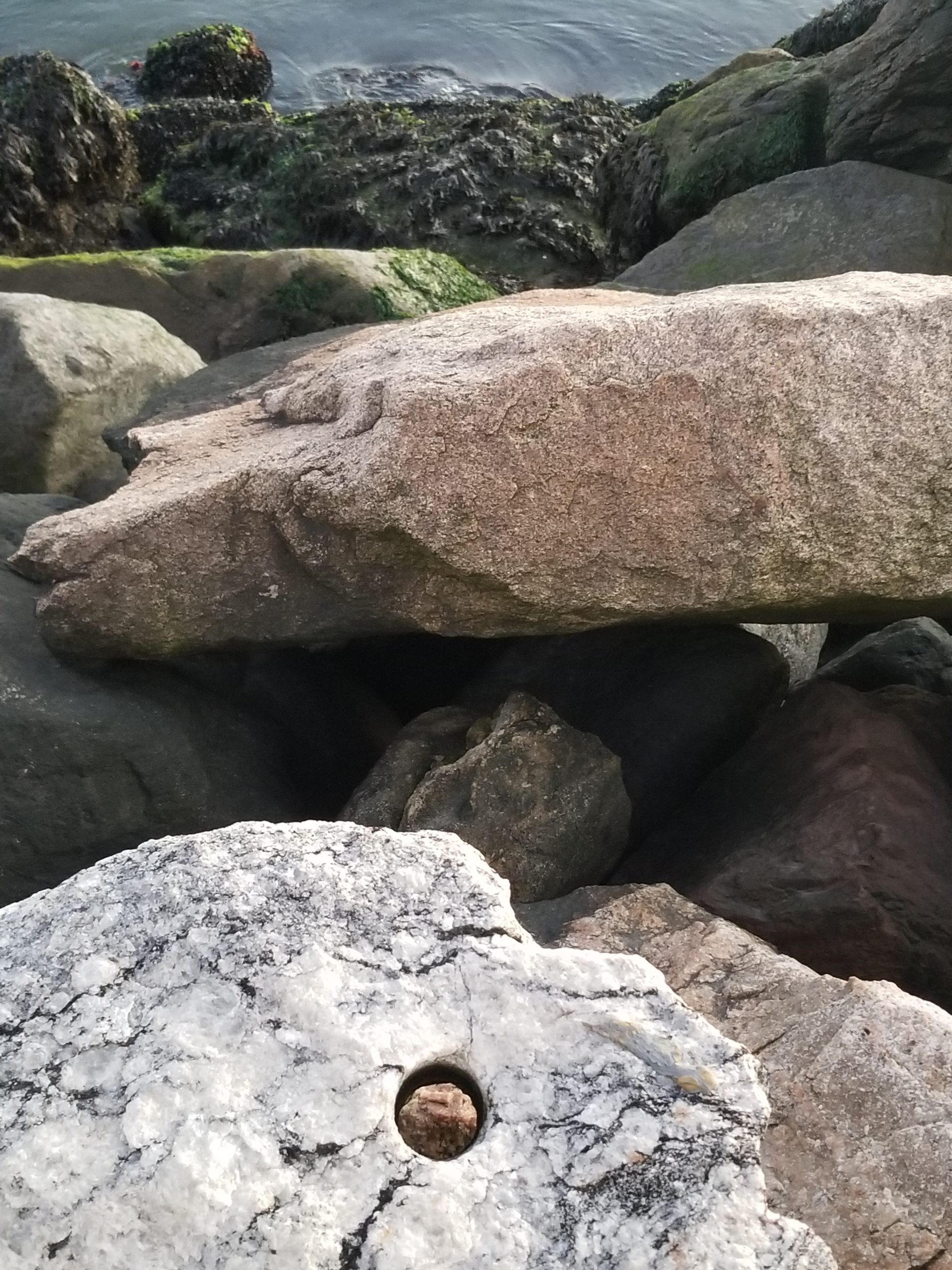
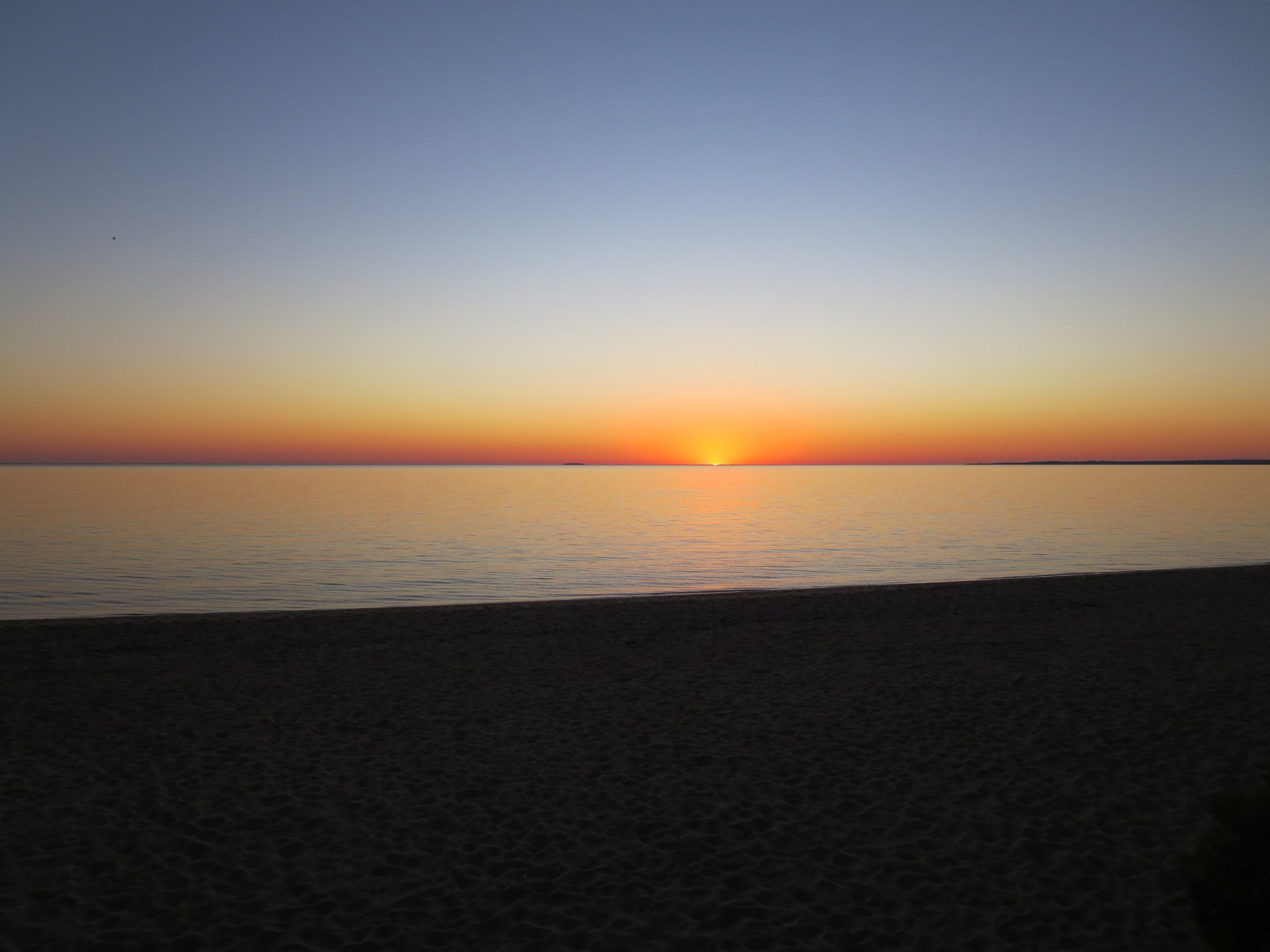
Photoshoots in Marchfield and Plainfield, VT, Fall 2022 Residency.
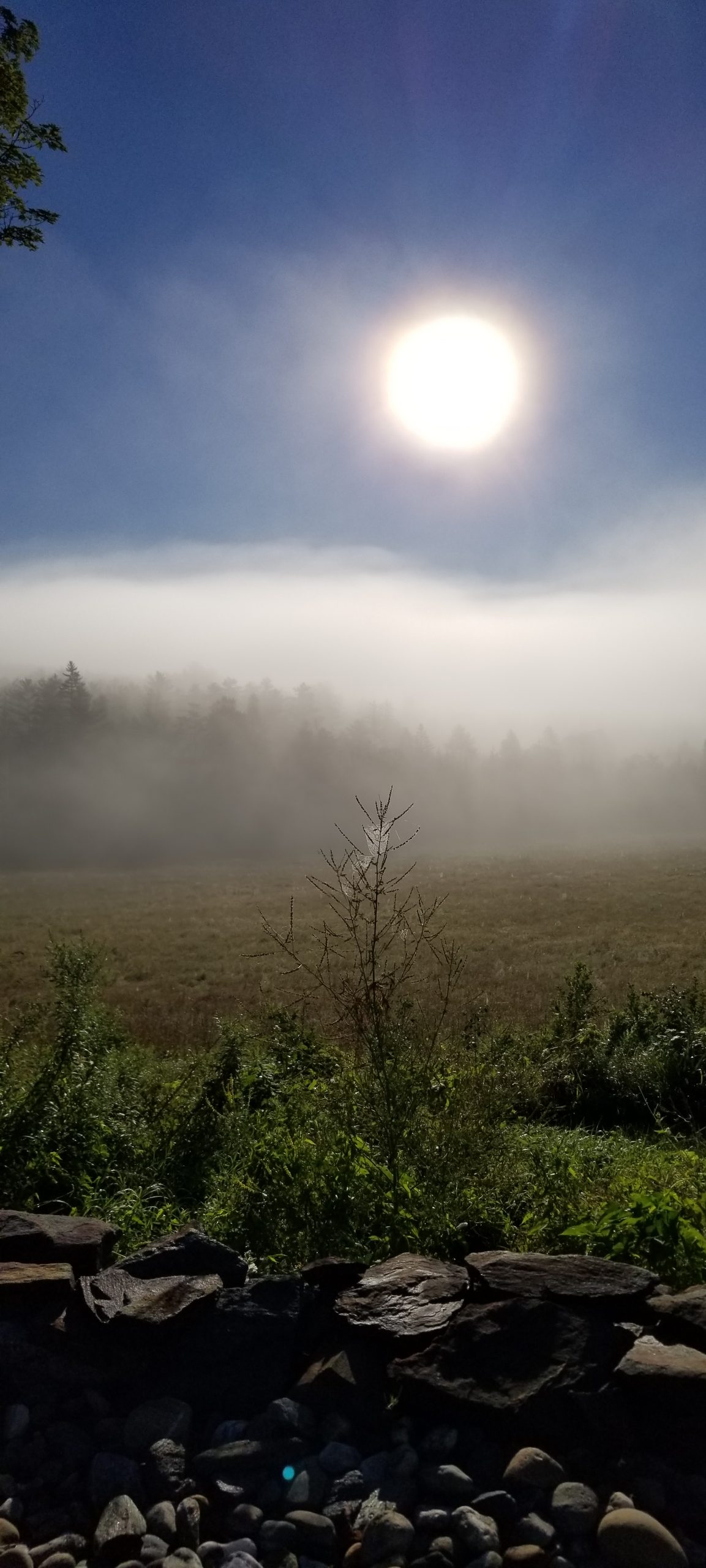

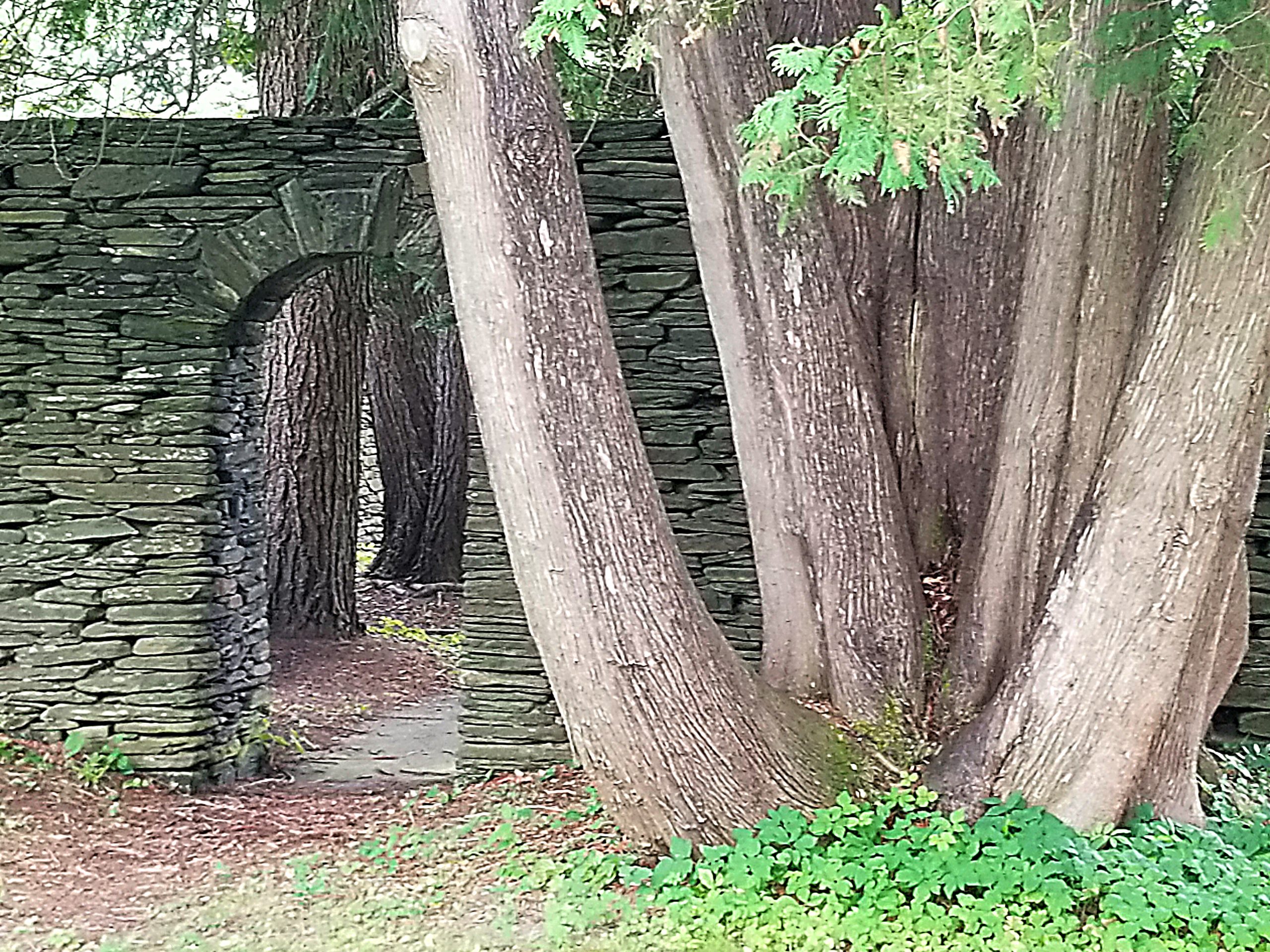
• My Community-Engaged Art Practice
Introduction to my Arts-Based Innovation Work:
Between 2011 and 2018 I created numerous workshops, alternative art exhibitions, and collaborative community initiatives around my region, whose purpose was to empower people to work collaboratively to imagine and realize economically and creatively empowered communities. Some core principles were helping people discover their own innate creativity, and dialogue skills building. Dialogue makes a place for multiple voices to have a place in the circle; seeks to identify common ground, and build on it; and seeks to build bridges across differences in a cooperative mutually-empowering way. I discovered Design Thinking principles in 2012. They inspired most of my workshops between 2014 and 2016. (What is Design Thinking?).
Body: Skin: Cocoon: Transformation: A Workshop in Experience Design:
Around 2017 – 2018, I began to feel my workshops needed to go deeper, to help people connect with their own inner compass, the inner voice each of us has that is our best guide in challenging times. Trusting one’s inner voice, one gains strength and confidence in one’s own abilities. Up to that point, most of my projects were one day workshops. I wanted to create some durational workshops where I and participants worked together with each other over a longer period of time, and therefore provide opportunities for people to reflect back on their experience, and allow for evolution in how these learning journeys were led.
My first effort was a week-long workshop in experience design written in 2017, Body: Skin: Cocoon: Transformation: A Workshop in Experience Design. The projects we create will always be an experience for someone— a person who gives a moment of their life to experience what we create. So how might we design experiences from the perspective of that person, an experience worth taking time for.
The workshop prototype was designed for a proposed Hybrid Studies Program at Parsons School of Design, whose curriculum was to be based on a curriculum framework of Body; Space; and Time. I chose the topic Body, and Skin. Skin is the largest organ in the human body. It is the place where we meet with and experience the world. The Hybrid Studies Program was cancelled, so the workshop remained a prototype. I’d planned to lead the workshop in my local community in my G1 semester. Because we were still not out of quarantine, and the workshop needed to be in person, I chose not to.
I decided to think of some workshop designs that were more suited to online learning, taking into account the zoom fatigue that we are all experiencing. I decided to try parts of the Cocoon workshop as mini-workshops during the semester, to test drive some of the methods in the workshop.
Two Online Mini-Workshops:
These are two 20 minute workshops I led during my G1 F21 Semester.
Mini-Workshop 1. “I’m in my skin, It feels like…”
In my G1 Residency advising group we were each asked to create a 20 minute mini-workshop for our group. I decided to use one piece of my “Cocoon” workshop, 1. to see how it worked, and 2. to try translating it into an online experience. I led our group in an exercise, called, “I’m in my skin, it feels like….” I began with a short guided contemplative grounding and centering exercise. Then I asked them to carry a pad of paper, and walk around their space, and write down as many ways to think about skin as possible. I talked about skin as the place where we meet with and experience our environment, the place where we experience touch and texture. I also talked about other types of skin, like the wall of a building being the “skin” between outside and inside; and cocoons, which are containers for transformation. The idea of the workshop was to encourage people to think about their projects as experiential containers for transformation. Participants offered a lot of creative imagery about what “the place where we meet with other” could feel like. The theme of skin also elicited unpleasant associations for some people. This took me by surprise. On person suffered from a skin condition, so skin was a painful association for him. He candidly and courageously shared his challenging experience with us. Another person was offended by using skin as the theme of the workshop, pointing out that for people of color, skin is a loaded topic for the kinds of experiences skin can draw to them, and that this workshop would be experienced very differently in a white community than for communities of color. While the workshop yielded some powerful, thoughtful responses, I decided it was too loaded a topic to be useful as a way to help people think about their projects in terms of experience design. The outcome for me is that I will probably not implement the “Cocoon” workshop, though I may borrow principles and aspects of it, for a redesigned future workshop in experience design.
Mini-Workshop 2. “Map Your World; Spiral Breathing; Cricket Shower”:
This workshop incorporated a combination of methods and influences I’ve been working with:
• The “Map Your World” exercise from Design For Change’s Design Thinking Teachers Guide; a design thinking guide for middle school children (which was included in my “cocoon” workshop).
• A spiral breathing sky-heart-earth exercise, I was shown by a teacher at Sunray Native American Elders Gathering (from Leadership Embodiment Workshop, by Olivia Cheever and Elizabeth Valentine).
• A video recording of crickets in a field. I’ve been experimenting with the way pure sounds in nature calm and enter us.
I emailed the group two days before my workshop and asked them as preparation to draw a map of their world: elements of their daily routine, and also bright spots, and hotspots: things feel good, and things that feel challenging. I asked them to bring their map to our session.
I began the workshop with a “Spiral Breathing” grounding centering exercise I learned from a Leadership embodiment workshop co-led by Olivia Cheever, a teacher at Sunray, during the annual Elders Gathering. I invited participants to turn off their video, and to stand or sit upright, and begin to breathe deeply. “Now visualize as you inhale: breathe up in a spiral from the center of the earth, through your heart, and up to the sky. On exhale, draw energy down I a spiral from the sky through your heart, to the center of the earth—a double helix. Take three more spiral breathes. As you do this, imagine that you cast a circle around you. Include all that is in your map in the circle, all the bright spots, all the hot spots. Because circles are inclusive. What we include in our circle can be transformed, changed. If we put something outside our circle we lose the power to transform it. Include the challenges, include nee solutions, even if you don’t know what they are yet. And call in wise Elders and allies—your posse—to help you hold the circle; the basket within which transformation can take place. Your posse can include people who inspire you, even if you haven’t met them, a pet or a loved one, a wise Elder, even a wise spirit you don’t know yet. Include all of these into our circle, and now spiral breathe into all of this. Continue until you feel complete, thank the circle, and return your consciousness to your stance. Now I ask you remain in your place, and experience a “cricket shower.” (I recorded a video of crickets as I was walking by a field in late summer.) I asked them to let themselves be permeated by the sound, and after the recording ended, I asked them to come back to the group in their own time. Lastly I requested that they take all that was in their circle, and all they experienced, and sleep on it. When everyone had returned to the circle, each person and a chance to share their map, and their experience of the workshop, and ask questions. The workshop was well-received, peoples maps were wonderful, and one person shared that the request to sleep on the experience was unexpected.
Cricket Shower Video
Field Research: My Creative Economy Catalyst Role at Launchspace Makers Space in Orange, MA
In fall of 2021, I was requested to help with community engagement at LaunchSpace, a new makers space in Orange, MA, due to my years of experience in arts-based innovation in Western Massachusetts, and Connecticut. The Launchspace director and I co-wrote a position for me as Creative Economy Coordinator. I included this in my G1 Semester Study Plan. Subsequently, the director chose to unilaterally redefined the position. I decided to revise my role to Creative Community Catalyst, as an independent field study role in support of Launchspace. In this role, I worked to encourage creative culture in the Orange community, and to increase community participation with Launchspace. The project was successful and increased membership. Some people joined and also started teaching classes there. I worked with Anthony Novak, Shop Steward for Launchspace’s 3D Printing, Laser Cutting and Engraving studio, to create displays which we put in several local libraries.
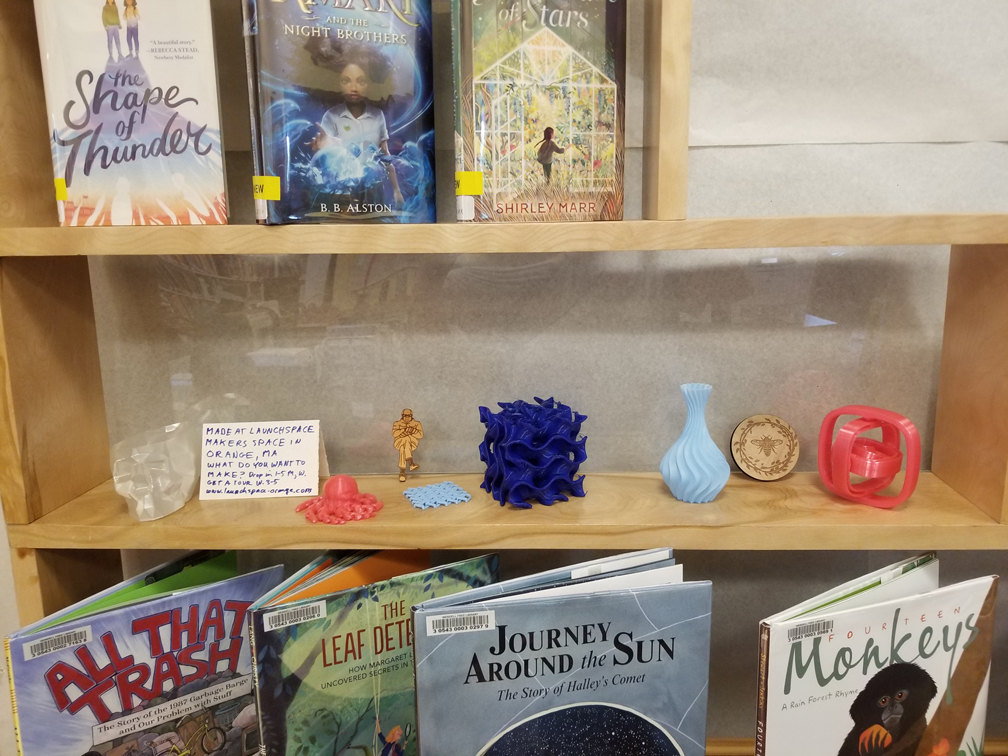
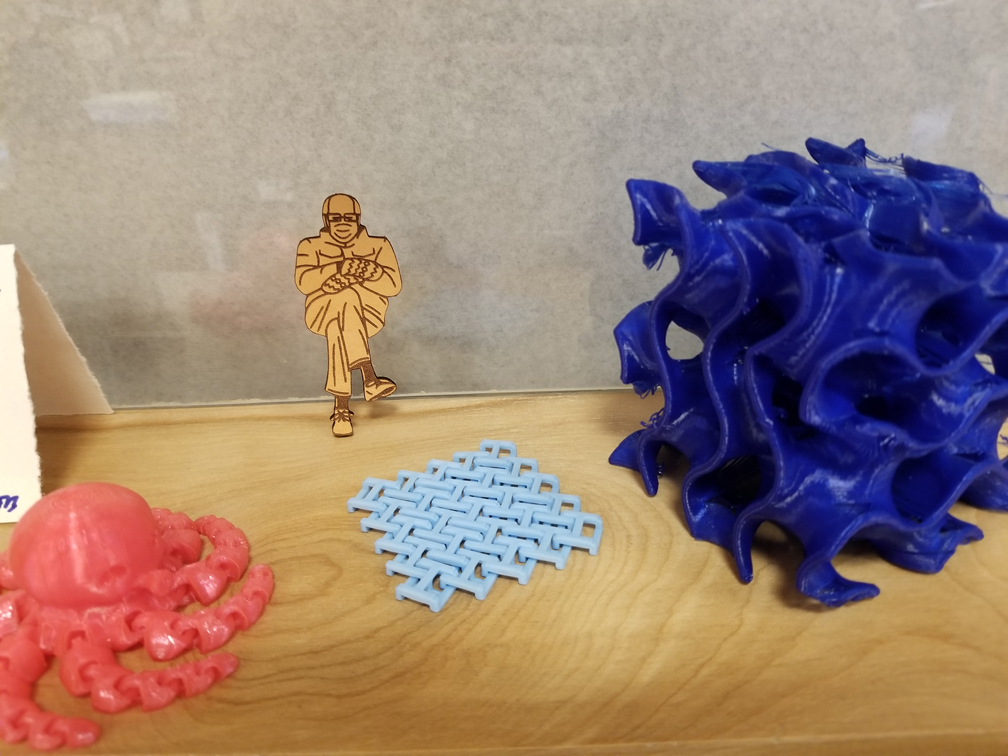
I did a display of these objects at a local coffee shop, while I ate lunch, to engage people in the cafe in conversation about the makers space. One person shared a wonderful history of manufacturing in the area. I visited a local art pop-up gallery, and a local crafts store to show objects made at Launchspace, and talk about creative community in the area. I wrote a confidential report, detailing my work as Creative Community Catalyst, my learning outcomes, and some recommendations for potential next steps and research.
Field Research: MIT U-lab 1x Course: Theory U: Leading from the Emerging Future
In fall 2021, I completed the MIT U-lab 1x course, “Theory U: Leading from the Emerging Future” led by Otto Scharmer, Senior Lecturer in the MIT Sloan School of Management, and Founder of the Presencing Institute (now U-School).
I was attracted to the premise of MIT Professor Otto Scharmer’s Theory U. His theory advocates going into a place of deep listening as the source to make decisions from. I liked the framework of Co-Initiating, Co-Sensing, Presencing, Co-Creating, and Crystalizing; and his four levels listening. Generative Listening, the deepest form of listening, is used to glimpse the future, and manifest an instance of the future in the present. The thesis of Theory U really affirmed my gut feeling that my community innovation work needs to go deeper; help people find their own inner compass.
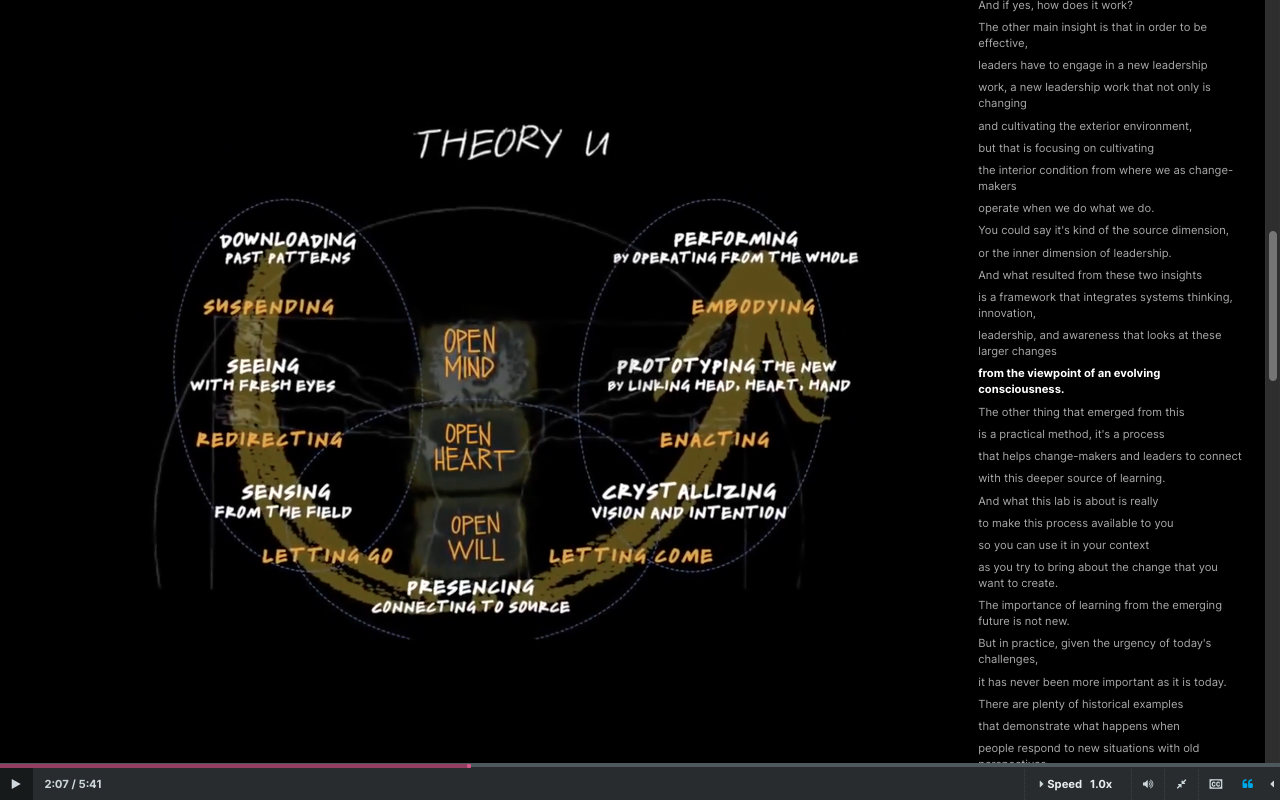
Theory U also tells us we can’t do this work alone, we must do it together, and “to change a system you have to have the courage to step into the unknown.” To this end, Presencing Institute created U-Lab Hubs where people can create and join a collaborative “hub” group focused around a common interest.
Traditional business project management borrows from what worked in the past and applies it to the present challenge. The problem with this approach is that it shoehorns the future into the past, causes stagnation, and suppresses innovative thinking that could better respond to the current situation. Scharmer asked himself whether it might be possible to lead from the future instead of the past. He founded Theory U, and the Presencing Institute to create a global community collaboration around this idea of leading from the future.
I completed the 14 week course; all the live sessions and assignments. One of the requirements was to join a u-lab “hub” around an area of interest. I joined the “Leadership and Business Transformation Hub,” a wonderful group with participants from around the world. Of all my experiences in this course, this global community was what most struck me. I was in one zoom seeing all these people in their living rooms; someone from Nicaragua; from Russia; from Beirut; from Brazil; from Australia; from France; from Spain—just human beings, all with good will and desire to support each other— and all our transformational projects. So many of the places people were zooming from are known as “hotspots” of conflict. The people before me simply wanted to build communities of connection and mutual support. It seemed to me that the conflicts in the news are being caused by a handful of powerful people who perpetuate a myth that discord and conflict are “necessary,” to “keep us safe.” The people in these zooms only had good will towards each other.
Field Research: u-lab 2x Course: From Prototype to Ecosystem Impact
Anyone who completes u-lab 1x is invited to apply to be accepted into the u-lab 2x accelerator course: From Prototype to Ecosystem Impact. I submitted an idea for a collaborative project, assembled a team of three people, and created a one-minute video presentation of the project. Our project was accepted. When my team began to meet, we immediately fell apart over poor collaborative communications skills. One person tried to take control of the group, and dictate demands of everyone else as a condition of remaining in the group. I realized my mistake in not establishing dialogue agreements for the group before inviting team members. This one member was blocking any ability for the group to function.
The U-lab 2x course includes “ask us anything” live sessions. I sought advice about this situation in one of these sessions. The meeting was very fast-paced, and we were put into timed breakout groups to pose our questions. My breakout group evaporated halfway through my framing of my problem, and suddenly I was in the main meeting gathering halfway through a sentence. From that experience I felt U-lab 2x was not creating the space for deep listening that Theory U principles advocate for. After several unsuccessful attempts to communicate to my team, I withdrew my project and dissolved the team. I could still form a new team, and restart my project. However, it seems to me that the u-lab 2x framework is still structured around business priorities of “creating a product,” and ‘producing results” on a time schedule. Since my project is about reuniting communities, I want to create a container where we can take as much time as needed to communicate. Dialogue skills are essential to community. Some things need plenty of time to bring things to harmony. My takeaway from u-lab 2x is that before establishing any group, dialogue-based communication agreements must be set as a requirement for any potential participant in a collaboration.
Prototype for our application to U-lab 2x:
Reweaving the Basket: Reconnecting Local Community Circles for Co-Leadership
Field Research: Change The Conversation Together's Deep Canvassing Training
In August and September 2021, I attended a training by Change the Conversation Together, of Brooklyn, NY. They train people to do “deep canvassing”, a form of deep community listening, to encourage non-voters to become regular voters. I wanted to learn how they are able to bridge across differences so successfully with total strangers. I participated in their “write your story” workshop in Fall of 2021. We were asked to write a story about a friend or relative who inspires us by their kindness. We were led through several iterations of our writing our story, and intentionally including the word “love” in our story. For example, “I love the way my friend…” These stories are shared to connect with the people that canvassers talk with. Change The Conversation Together focused their efforts on Pennsylvania in the 2020, and 2022 election cycles. In 12,821 conversations deep canvassers had, the people they spoke with were 29% more likely to vote. Many non-voters they spoke with now see themselves as regular voters. The training was great. I could do it a couple more times to gain more skill.
Practicum: Designing and Leading Co-Designing Curriculum Together CLO in Fall 2022.
This fall G2 semester, I designed a Collaborative Learning Opportunity, “Co-Designing Curriculum Together.” My advisor, JuPong Lin offered to co-lead it with me. I agreed. This semester my study plan was focused on the community-engaged arts innovation part of my practice.
Why a CLO?
• At Goddard, where each person designs their own curriculum, I wanted to see how other people designed their study plans, and thought about their practice.
• I wanted to have a space where we could share our study plans and discuss our practices together, to have the opportunity to be inspired by each others’ work, ideas, ways of thinking.
• I wanted to do a teaching assistantship—an opportunity that Goddard doesn’t offer. Leading a CLO in an area of interest could provide me with experience designing and leading a semester-long class.
Designing the CLO:
I wanted to create a dialogue-based foundation for the CLO. Dialogue is a foundational principle in the Design Thinking workshops I taught. First because it allows multiple ideas to be in the circle. Second, because it keeps collaborations from devolving into debate, which divides people, and kills creative flow. My experience from my u-lab 2x project taught me that I needed to create the dialogue-based agreements, and put then in the invitation for the CLO, so that participants would know this up front when considering whether to join the CLO.
I led many one day design thinking courses in my local community. One design thinking principle is “make the space remember.” I would fill the room where the workshop was held with principles from the workshop curriculum. I would teach in a circle around the room, with the curriculum going from left to right around the walls of the room. That worked magnificently in the real physical space we had our workshops in. It felt like a playground for grownups, perfectly equipped for the work we were to do.
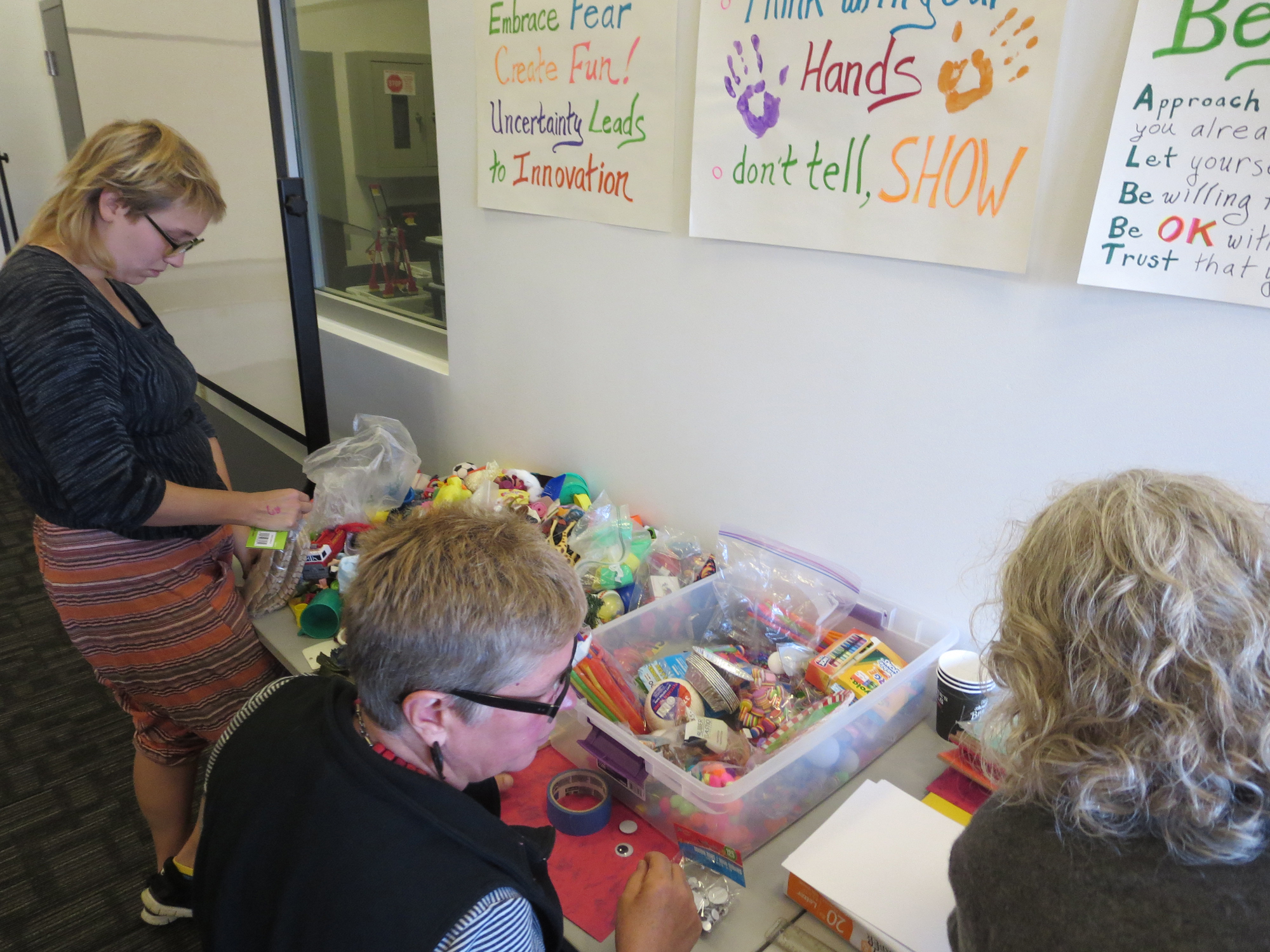
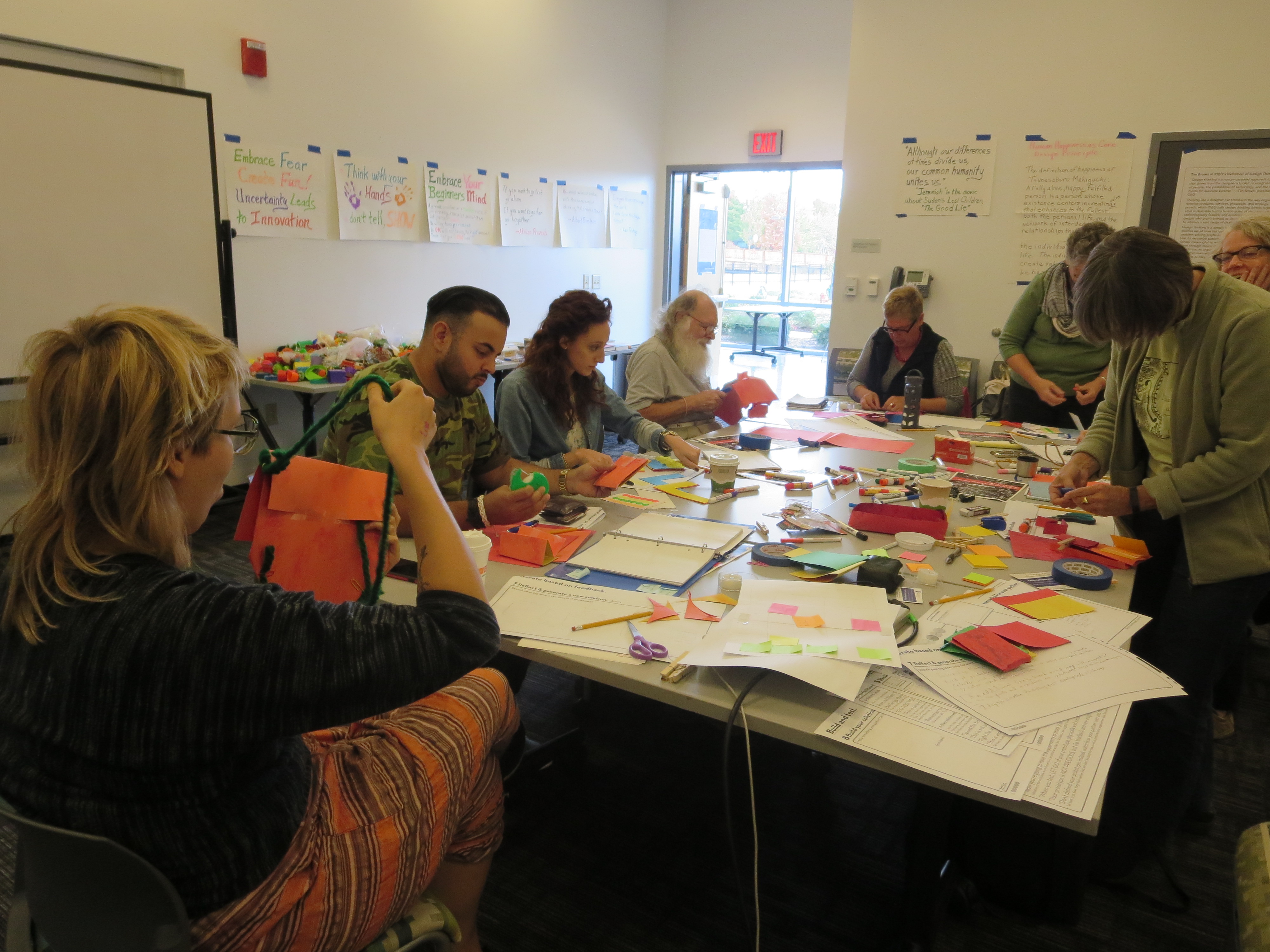
For the “Curriculum CLO,” I wanted to create a virtual playground space in a dedicated google drive folder. I created a series of folders, with curriculum building resources from progressive pedagogies. I created a shared google doc, where people could engage with each other, post questions, ideas, and projects. I created individual folders for each participant to use however they wished.
Leading the CLO, Learning Curve:
However, this attempt to translate my physical workshop spaces into a virtual workshop space failed. People barely engaged with the resources in the virtual space at all. As a new attempt to get people to engage with the content of the CLO, I assigned a project for each of the students to create a learning journey to lead our group in. I created time slots, and asked participants to sign up for a time to present.
In the second of our four sessions, I prepared a 20 minute mini-workshop for my learning journey. We were nearing the third session, and no one was signing up to do a learning journey.I felt like the CLO project was failing. Three of the original five participants had dropped out due to personal circumstances. The remaining two also had extenuating personal circumstances. One was in Florida the projected path of Hurricane Ian, my other remaining student had water damage in her apartment, and had to move mid-semester.
I reached out to JuPong, who was invaluable in helping talk me through this difficult moment. There were two remaining sessions in our CLO. I decided to reach out to the students, and suggest that since everyone was overwhelmed with unforeseen circumstances, we could do the homework in class together. They could use their session to present about a learning journey they were working on. It could be a work-in-progress, they could show us what they were creating, and what parts they wanted feedback on, or were still trying to figure out. Everyone loved this idea, and it worked beautifully. It was such a simple format: just make spacious time, really listen, and give people your full attention to talk about their work, and get feedback. Everyone completed their learning journey, JuPong even requested a session to present on some restorative justice ideas she was working with.
Participant Presentations
At the end of the final session, we all did a debrief of the CLO. We all agreed that it should continue in some form. I may re-offer the CLO next semester as a “Come as you are” feedback opportunity for what people are working on.
Takeaways: I learned some important things from this experience.:
• Just keeping things very simple and creating an invitation, offering to listen, and creating space was what worked beautifully.
• Filling a google drive with resources took away the open space people need to feel engaged and participate. In my physical workshops, the posters on the wall set a wonderful energetic tone for the workshop. They held the circle, with the people at the center of the space. I will have to find an online way where people remain the center, and still provide a way of providing the curriculum content so it is accessible.
I asked students to review our CLO in a questionnaire. One participant said that while the CLO provided a rare opportunity to have one’s work considered in depth, the workshop did not assist her in designing curriculum—one of the stated goals for the CLO. Originally I wanted to do a lot more sessions, but the CLO format is generally limited to four sessions. I don’t believe four sessions are enough to properly cover the topic of designing curriculum, especially for learning progressive curriculum models. To be successful, such a course would probably need to have weekly sessions for a whole semester.
